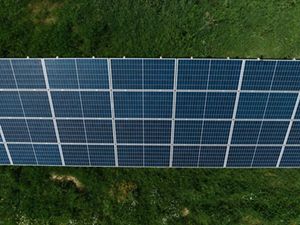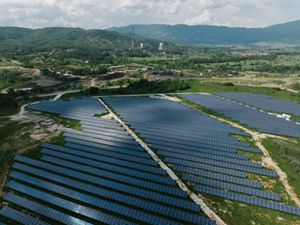Europe Needs to Triple Renewable Capacity by 2030, and Community Buy-in is Critical
As guidance rolls out to accelerate the energy transition, we must learn from what’s working to engage and empower communities in the process.
By Elif Gündüzyeli, The Nature Conservancy, and Sanna Markkanen, Cambridge Institute for Sustainability Leadership
Enabling a Community-Powered Energy Transition
Good practices for engaging stakeholders, fostering collaboration and promoting benefits
Download the reportEurope is working at breakneck speed to achieve the 2030 climate goal to cut emissions by 55% and increase the share of renewable energy to as much as 45%.
This week, in time for the second anniversary of REPowerEU, the European Commission published a package of guidelines to help EU countries identify where and how renewables will be deployed in support of the 2030 targets.
The package, including detailed guidance for the designation of Renewable Acceleration Areas, as well as updated guidance on permitting and non-price criteria in auction design, comes at a critical time: Europe must go smart to go fast on renewables deployment.
Solar and wind energy reduce our dependence on expensive and polluting fossil fuels, as demonstrated in Europe in the last two years.
Their accessibility allows for energy generation near the communities that require it. However, their deployment takes up space, and the places they need to be deployed are crowded.
The success of renewable energy initiatives is not solely determined by the number of GWs of installed capacity, the efficiency of solar panels or the height of wind turbines.
Rather, it is fundamentally connected to the integration, acceptance, and active involvement of the communities where these projects are planned and implemented—as well as the inclusion of their voices in the decision-making processes.
Quote
The success of renewable energy initiatives...is fundamentally connected to the integration, acceptance, and active involvement of the communities where these projects are planned and implemented—as well as the inclusion of their voices in the decision-making processes.
The social acceptance challenge has to be addressed, not dismissed
As the number and size of new projects increases, so will the likelihood that more will need to be built closer to existing communities—converting land use.
This will heighten the risk of local opposition, whereby communities seek to slow down or prevent new projects due to a variety of concerns.
To meaningfully address this discord, it is essential to move beyond the broad and reductive description of NIMBYism (Not in My Back Yard) to understand the multi-faceted and valid reasons why citizens can oppose renewable energy projects.
In the absence of coherent and shared standards for community engagement and benefit sharing, new research highlights the need to transform community engagement from an instrumental means-to-an-end process to a more empowering strategy.
Without genuine engagement, which includes two-way conversations, renewable energy projects risk becoming disconnected from on-the-ground realities. This can lead to resistance and, ultimately, hinder deployment.
Currently, communities are engaged primarily during the Environmental Impact Assessment phase, often limited to one-way communication that relies on understanding a lengthy, technical report.
However, social acceptance may pose challenges if one-directional community outreach is labelled as consultation. Without genuine engagement, which includes two-way conversations, renewable energy projects risk becoming disconnected from on-the-ground realities. This can lead to resistance and, ultimately, hinder deployment.
According to the findings outlined in the study, adequate and equitable community engagement needs to start before the project development phase at the spatial planning stage.
Once there is consensus on spatial maps, developers need to engage communities through project design and development phases, consistently informing and listening to communities throughout the project lifetime, including decommissioning.
Continued engagement beyond completion can help build trust and enhance equitable benefit-sharing schemes.
It's a shared public-private matter
Community benefit programmes can significantly increase local support for new renewable energy infrastructure. Recent field research shows that projects delivering community benefits enjoy much broader overall support.
However, these benefits need to be equitably distributed, direct, straightforward and tailored to address the needs and priorities of the affected and vulnerable populations.
When community benefits are distributed through a community fund, it is crucial for community members to have control over how these funds are utilised.
The EU aims to achieve up to 45% of renewables in the energy mix in the next six years. However, the lengthy permitting times, which can stretch up to nine years for solar and wind projects, raise doubts about the achievability of these ambitious targets.

Empowering communities through meaningful engagement and fair benefit-sharing mechanisms demands time, forward planning and commitment from governments and developers.
However, the absence of these actions can cause project delays and cancellations, which would incur much higher costs in terms of time and finances. Widespread opposition to renewable energy projects could also jeopardise the energy transition we urgently require.
The EU aims to achieve up to 45% of renewables in the energy mix in the next six years. However, the lengthy permitting times, which can stretch up to nine years for solar and wind projects, raise doubts about the achievability of these ambitious targets.
While permitting (rightly) includes various administrative processes required to get a project online, research and developers’ experience show that thorough biodiversity considerations and community buy-in significantly reduce project risks.
Brussels has to be loud and clear
Renewable energy projects can deliver multiple benefits for individuals, communities, the environment and investing companies. However, community engagement is not merely optional—but essential—for their success.
Despite some progressive renewable energy developers having adopted good practices for community engagement and benefits sharing, we lack a framework for stakeholders to collectively devise strategies to address community concerns, promote equitable implementation and decision-making and optimise for positive community outcomes.
Establishing industry-wide best practices to mainstream community engagement and benefit sharing is imperative. Energy sector businesses need to integrate system value—i.e. actions that benefit society, the economy and the environment—into company strategies.
Quote
Despite some progressive renewable energy developers having adopted good practices ... we lack a framework for stakeholders to collectively devise strategies to address community concerns, promote equitable implementation and decision-making, and optimise for positive community outcomes.
Regional, national, and local governments play pivotal roles in facilitating better practice. The EU should introduce consistent, coherent and shared standards for community engagement and benefit sharing.
Governments should encourage robust community consultation and benefit-sharing arrangements, possibly mandating them and providing incentives for high community engagement and biodiversity standards. This would ensure a level playing field and enhance the competitiveness of developers with comprehensive community engagement plans and strategies.
The European Commission's guidance package could be a game changer for both a rapid and equitable energy transition. All three sets of guidelines include chapters on the need for adequate and early community engagement, even including fair community benefits as non-price criteria in auctions.
But it’s crunch time now, and implementation will be key. Europe can set the global standard for community engagement, benefit schemes and equity in the renewables roll-out. Now is the time to take it.
Let's Make Breakthroughs Break Through
The climate and biodiversity crises are interconnected and daunting. But by working together, we can overcome the barriers to the solutions our planet needs. Get our monthly newsletter and join a community of changemakers.






